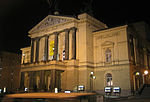National Museum (Prague)
1818 establishments in the Austrian EmpireCultural infrastructure completed in 1891Czech nationalismDomesHistory museums in the Czech Republic ... and 6 more
Museums established in 1818Museums in PragueNational Cultural Monuments of the Czech RepublicNational museumsNatural history museumsTerminating vistas

The National Museum (NM) (Czech: Národní muzeum) is a Czech museum institution intended to systematically establish, prepare, and publicly exhibit natural scientific and historical collections. It was founded in 1818 by Kašpar Maria Šternberg. Historian František Palacký was also strongly involved in the foundation of the museum. The National Museum houses nearly 14 million items from the areas of natural history, history, arts, music and librarianship, which are located in dozens of museum buildings. The main building of the National Museum has been renovated in 2011–2019, and permanent exhibitions are gradually being opened from Spring 2020.
Excerpt from the Wikipedia article National Museum (Prague) (License: CC BY-SA 3.0, Authors, Images).National Museum (Prague)
Mezibranská, Prague New Town
Geographical coordinates (GPS) Address Nearby Places Show on map
Geographical coordinates (GPS)
| Latitude | Longitude |
|---|---|
| N 50.078830555556 ° | E 14.430797222222 ° |
Address
Historická budova Národního muzea (Hlavní budova Národního muzea)
Mezibranská
121 32 Prague, New Town
Prague, Czechia
Open on Google Maps









